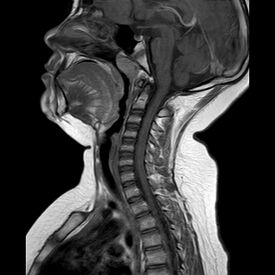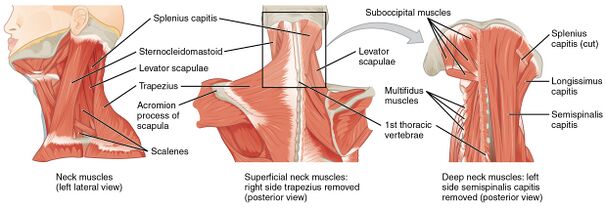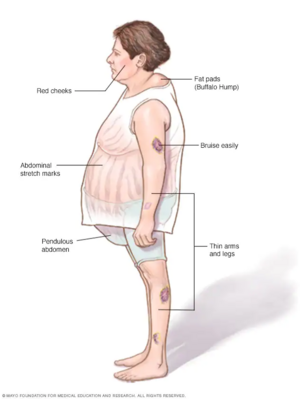Neck Hump
Original Editor - Sehriban Ozmen
Top Contributors - Sehriban Ozmen and Lucinda hampton
Definition[edit | edit source]
The neck hump is a postural change that develops in the dorso-cervical area due to different causes such as postural issues, some diseases, medications, obesity and genetic factors.
Clinically Relevant Anatomy[edit | edit source]
The posterior region of the neck predominantly includes subcutaneous fat and skeletal muscle. [1]
See the page on the cervical anatomy or more pages on the cervical anatomy category to understand more of the relevant anatomy.
Aetiology[edit | edit source]
- Cervical Lipodystrophy: Refers to a metabolic change seen in HIV-infected patients receiving highly active antiretroviral therapy. Lipohypertrophy (localized abnormal fat accumulation) as an adverse effect of the medication, may occur in the dorso-cervical area. [2]
- Dowager’s Hump: It refers to the curvature with a Cobb angle of more than 40 degrees in hyperkyphosis. [3] It can be due to muscle weakness or sensory deficits [4] and if left untreated can lead to functional limitations, increased risk of falls and vertebral fractures, and low quality of life. [3]
- Cushing's Syndrome: One of the signs of this syndrome is supraclavicular/dorsocervical fat pad (buffalo hump) with a prevalence rate of 50%. [5]
- Madelung's Disease: Also known as Launois-Bensaude Syndrome [6], is a rare disorder of adipose metabolism and refers to multiple, symmetrical lipomatosis / benign symmetric lipomatosis. [7][8] Nonencapsulated lipomas (fatty masses) can present in different parts of the body, including the neck. [9]
- Osteoporosis: One of the clinical symptoms of osteoporosis in older adults is dowager’s hump. [10]
- Obesity: A study [11] showed a meaningful difference between the obese and control group with more cases of adipomastia, and buffalo hump seen in the obese group.
- Genetics: Although any specific gene to cause buffalo hump has not been declared, it is known that some people may have a genetic predisposition to obesity and fat accumulation in certain areas of the body, thus having buffalo hump.
Treatment[edit | edit source]
Prevention of the formation of a hump is easier than overcoming one. It is feasible to treat a neck hump that has formed. Initially the cause needs to be ascertained by eg a physiotherapist, who will undertake an assessment.
- A neck hump of long standing hump will prove more difficult to improve than one that is forming.
- An appropriate individualised plan of treatment adhered to over weeks and months, and a change in eg postural habits can bring about gradual improvements.
- The earlier treatment is implemented the more successful the plan will be.
A case study [3] implemented an integrated therapy for the patient with Dowager’s hump at the cervicothoracic junction. The therapy consisted of the following:
- Chiropractic therapy consists of spinal manipulative therapy, cervical extension-compression traction, and Guasha (instrument-assisted soft tissue mobilization) to correct the spinal alignment.
- Ergonomics recommendations such as an office workstation set-up.
- Core-muscle exercises to improve the forward head posture and hyperkyphosis and increase lumbar lordosis to compensate for the postural change.
The study resulted in the improvement of symptoms and range of motion. And it also emphasized the crucial role of patients’ education in maintaining correct posture in daily activities to prevent the recurrence of Dowager’s hump.
A prospective study [12] investigated 52 patients with antiretroviral-induced lipodystrophy syndrome referred for surgical correction (19 patients had liposuction for their dorsal humps). The overall result was a significant decrease in triglyceride, total cholesterol, and LDL cholesterol levels after the surgery in patients with elevated preoperative levels.
Resources[edit | edit source]
Effect Of Mckenzie Exercises On Functional Neck Disability In Females With Dowager’s Hump [13]
References[edit | edit source]
- ↑ Moss WJ, Finegersh A, Narayanan A, Gillard D, Califano J, Brumund KT, Coffey CS, Orosco RK. Characterizing posterior neck masses: a single-institution retrospective and systematic review. Ear, Nose & Throat Journal. 2021 Sep;100(5_suppl):766S-70S.
- ↑ Carrese E, Morandi U, Stefani A, Aramini B. Total thyroidectomy in HIV positive patient with buffalo hump and taurine neck. International Journal of Surgery Case Reports. 2019 Jan 1;61:64-6.
- ↑ 3.0 3.1 3.2 Chau C, Chu EC, Huang KH, Tam D, Cheung G. Remission of Dowager’s hump by manipulative correction of spinal alignment: a case report. Journal of Medicine and Life. 2023 Jun;16(6):957.
- ↑ Chu EC, Wong AY. Cervicogenic dizziness in an 11-year-old girl: a case report. Adolescent Health, Medicine and Therapeutics. 2021 Nov 26:111-6.
- ↑ Savas M, Mehta S, Agrawal N, van Rossum EF, Feelders RA. Approach to the patient: diagnosis of Cushing syndrome. The Journal of Clinical Endocrinology & Metabolism. 2022 Nov 1;107(11):3162-74.
- ↑ Jang N, Shin HW, Kim J, Yoon KC. A case report of Madelung’s disease. Archives of Craniofacial Surgery. 2020 Oct;21(5):305.
- ↑ Tsilivigkos C, Mastronikolis S, Lygeros S, Tsilimpoti D, Papadas T. Multiple symmetric lipomatosis (Madelung's disease) with symptoms and signs of hypertension, lipodystrophy, and dyspnea: A case report and literature review. Clinical Case Reports. 2021 Jun;9(6):e04288.
- ↑ Liu SZ, Zhou X, Wang YP, Liu Y, Song A. The Madelung’s disease and the buffalo hump sign. QJM: An International Journal of Medicine. 2020 Mar 1;113(3):219-.
- ↑ Nisi G, Sisti A. Madelung's disease. New England Journal of Medicine. 2016;374(6):572-.
- ↑ Zhang Q, Cai W, Wang G, Shen X. Prevalence and contributing factors of osteoporosis in the elderly over 70 years old: an epidemiological study of several community health centers in Shanghai. Ann Palliat Med. 2020 Mar 1;9(2):231-8.
- ↑ Gün E, Uzun H, Bolu S, Arslanoğlu İ, Kocabay K. Serum 25-hydroxyvitamin D is associated with insulin resistance independently of obesity in children ages 5–17. Primary care diabetes. 2020 Dec 1;14(6):741-6.
- ↑ Doucas G, Liakos D, Koonin SD. The effect of lipectomy/liposuction on lipid profiles in antiretroviral drug-induced lipodystrophy syndrome. Plastic and Reconstructive Surgery Global Open. 2020 Oct;8(10).
- ↑ Abd Elmeged NA, Ibrahim AH, Labib AM, Ahmed AR, Mohamed GI, Kamal HA. Effect of mckenzie exercises on functional neck disability in females with dowager’s hump. Egypt. J. Appl. Sci. 2021;36:163-82.









